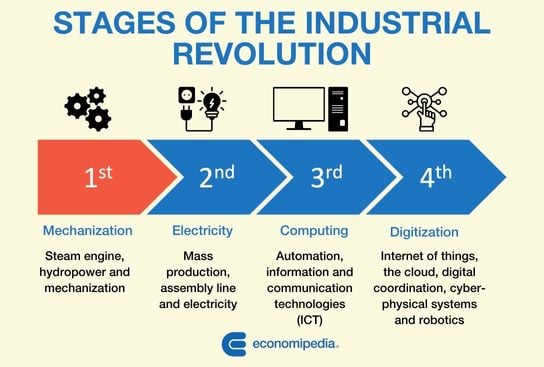Industrial revolution
The Industrial Revolution was a process of profound economic, social, cultural and technological transformation that took place between 1760 and 1840 and originated in England.
The Industrial Revolution marked a before and after in the history of mankind. Especially because its impact extended to all areas of society.
Examples include significant progress in transport, improved productivity and rising per capita incomes.
In short, it meant the creation of technological and scientific innovations that represented a break with the socio-economic structures that had existed up to that time.
It became known as the First Industrial Revolution after a new industrial revolution, known as the Second Industrial Revolution, took place years later. The 20th and 21st centuries saw the Third Industrial Revolution and the Fourth Industrial Revolution, respectively.
Before continuing, and as a curious fact, it is worth noting that advertising as a discipline originated on this date.
Origins of the Industrial Revolution in England
The Industrial Revolution originated in England, where the political, socio-economic and geographical conditions were right. But when was the Industrial Revolution? It began around 1760 and ended in the 1840s.
The steam engine was the basis for all the development that came about as a result of it. This invention was possible thanks to certain elements, such as the existence of fuels like coal and iron.
Alongside these elements, other factors enabled the Industrial Revolution to emerge, develop in England and bring about important changes that had a major impact on society.
Causes of the Industrial Revolution
Among the most important causes of the First Industrial Revolution were the following:
Political causes
On the one hand, the bourgeois revolution of the 17th century had triumphed, bringing about the abolition of the feudal system. The system was based on a monarchy that had discarded the absolutism found in other European countries.
As a result, England experienced a period of stability, with no revolutionary upheavals and greater civil liberties.
Socio-economic causes
On the other hand, England enjoyed a situation of abundant capital, given its commercial supremacy. Control of trade with the colonies led to a process of concentration of capital in the hands of a few businessmen. The fortunes that originated in the trade of products such as tea, tobacco and even slaves were important.
Equally important was the existence of an abundant labour force. The innovations that took place in the countryside led to an increase in productivity, which meant that more food could be produced. This process became known as the agricultural revolution, resulting in an increase in population.
As a result of this increase in population meant, in turn, an increase in available labour that was not productive in the countryside. This led to a significant rural exodus with the transfer of large numbers of people from the countryside to the cities. This displaced population would become a pool of available labour for industrial work.
Geographical causes
The existence of certain raw materials in the territory of England also facilitated the process. Iron and coal were instrumental in enabling the development and spread of innovations such as the steam engine.
Moreover, as an island territory, it was at an advantage in terms of international trade in its products thanks to the steamship.
Consequences of the Industrial Revolution
Just like the causes that led to the Industrial Revolution, the consequences were felt in different areas. Thus, in summary, the consequences of the First Industrial Revolution can be divided into three blocks.
Mechanisation of labour and large factories
Mechanised production led to a decline in craftsmanship. This new form of production meant that workshops were displaced by large manufacturing centres. This, in turn, led to an increase in the production of different types of products, especially textiles.
Changes in economic structure and society
With the expansion of large industrial production centres, a new social class was created: the industrial proletariat. The characteristics of these workers, concentrated in these spaces, broke with the nature of the workers of earlier times.
In the emergence of this class and its peculiar working and living conditions we can trace the origin of trade unionism and new ideologies, such as socialism.
Urban sprawl and rural exodus
On the other hand, cities began to grow in a very significant way. If the arrival of the rural population in the cities was one of the causes of it, this phenomenon multiplied later on. At the same time as the mechanisation of the countryside went hand in hand with the introduction of new technologies, the surplus labour force increased.
As a consequence, the rural exodus to industrial areas changed the structure and size of the cities. This meant that living conditions, especially from a hygienic and sanitary perspective, were very precarious. Many people lived in small spaces in an environment where services, such as sewerage and access to drinking water, were deficient, which led to major health problems.
Characteristics of the Industrial Revolution
Based on the causes, consequences and the whole development of it, we can establish different characteristics:
- Large increase in mechanised production.
- Changes in the social structure.
- Unprecedented economic and industrial expansion.
- Increased productivity, thanks to advances in technology.
- Major improvements in means of transport.
- Strong increase of the urban population, to the detriment of the rural population.
- Changes in consumption habits.
- Transformation of the productive structure.
- Transition from the primary to the secondary sector. Above all, textiles and metallurgy.
- Boosting coal as the main energy source.
Inventions of the Industrial Revolution
The most important inventions of the it include the following:
- Spinning machine (1767).
- Steam engine (1769).
- Steamboat (1787).
- Railway (1814).
- Bicycle (1817).
- Typewriter (1829).
The First Industrial Revolution in France and other European countries
With all these elements, it was a real turning point in the history of mankind.
Western societies and a large part of the world are directly influenced by this phenomenon, which brought about unprecedented changes. The economy, means of transport and communication, and even social structures would not be the same if England had not hosted that revolution.
Proof of this was the spread of it in Europe, especially in countries such as France. Although it developed slowly and gradually throughout the 19th century, it generated major transformations in the French economy.
Stages of the Industrial Revolution
After the First Industrial Revolution (1760-1840), successive stages can be established that led to changes in other areas.
In other words, it was followed by three further phases:


